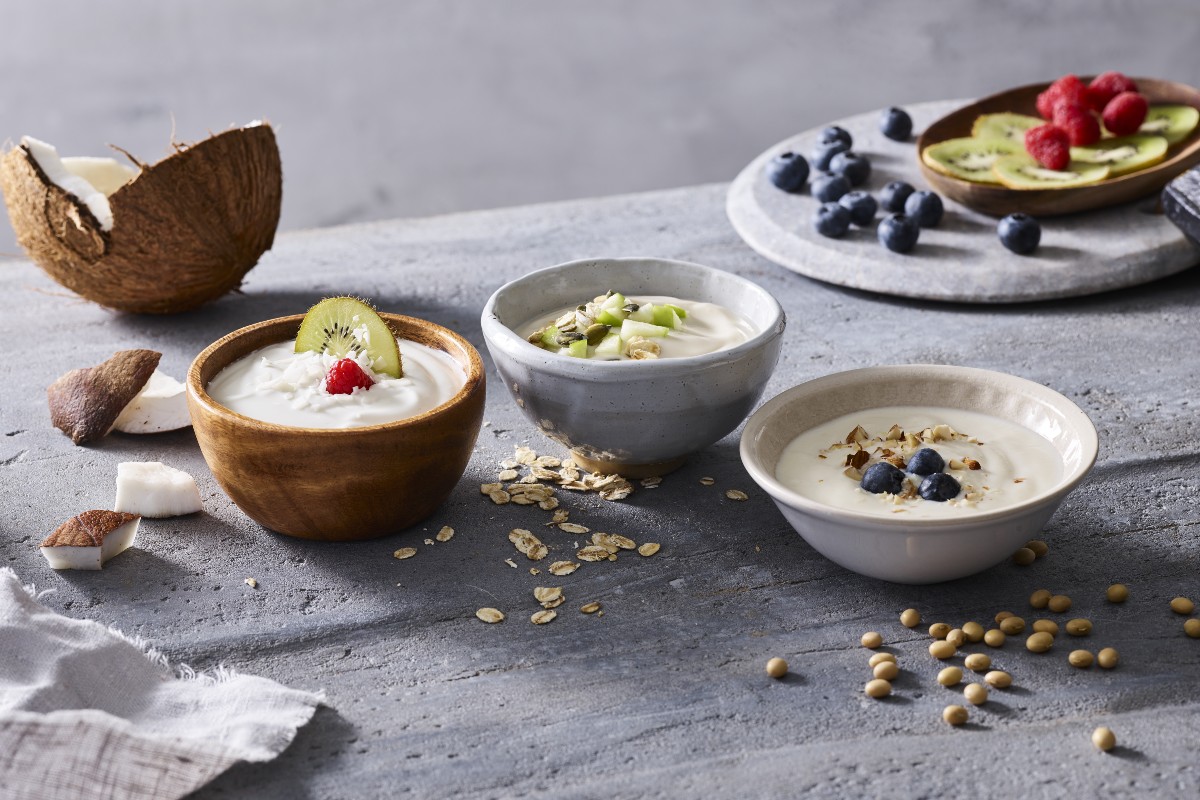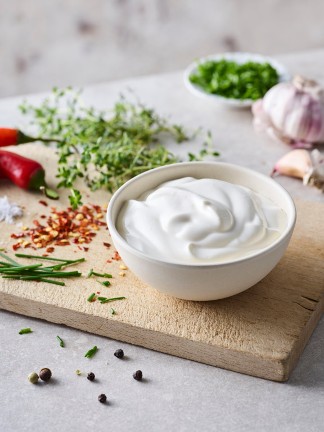Dairy milk – from cows, goats and sheep – is a complex liquid. It’s composed mostly of water, but also contains fat, protein and sugar. And when cultures and enzymes are introduced into this system, the milk may get converted into cheese, sour cream, yogurt and other fermented foods, such as kefir, quark and skyr.
Cultures and enzymes also have other roles. When live and active probiotic cultures, for example, are added to dairy products, they may provide a positive effect on the consumer’s gastrointestinal system, which improves digestion and boosts immunity. In other instances, cultures and enzymes influence the flavor, texture and even the shelf life of dairy products. Innovations are infinite when a formulator works with these tools from Mother Nature.
The evolution
Scientists are constantly searching for new cultures and enzymes in nature. They are found in all living organisms – animals, plants and algae – and are the workhorses of life. They are small – in fact, usually too small for the human eye – but make a big difference everywhere they touch.
Cultures are living organisms and evolve over time. They remain live and active in dairy applications unless the product undergoes a heat treatment or some other deleterious shock.
Suppliers ensure that cultures effectively perform the function promised. This enables a predictable fermentation time and yield, as well as a consistent finished product that meets specifications. Suppliers also control for bacteriophage, which are the viruses that infect bacteria and contribute to fermentation failure.
Enzymes are proteins that act as catalysts to speed up a desired reaction. Every enzyme performs a specific task, with its active site recognized for the ability to modify a compound on a substrate. Once the enzyme does its work, it becomes an inactive compound without any direct impact on the product’s sensory attributes. Often times, after completing a reaction, steps are taken to deactivate the enzyme to prevent it from further reacting. This may be accomplished through heat, change in pH, high pressure, etc.
“Enzymes are processing aids and do not need to be labeled on the final ingredient list if they are inactivated prior to packaging,” said Joshua Chavkin, sales and marketing associate, Enzyme Development Corp., New York.

Suppliers have invested heavily in the identification, isolation and commercialization of these clean-label functional ingredients, for both dairy and plant-based alternatives. Consumers understand the simplicity and naturalness of cultures and enzymes when they appear on ingredient statements, while manufacturers appreciate their efficiency and ability to produce consistent product.
“The biggest difference in culture and enzyme selection for dairy and alt-dairy is the goal of the manufacturer,” said Becca Henrickson, marketing manager-food cultures and enzymes, Chr. Hansen Inc., Milwaukee. “Fermentation processes are well-established in the dairy industry and producers are trying to increase productivity and create innovative experiences and products for the market.
“In alternative dairy, the industry is still very new and can require more lab time to determine the right solution for a specific product base,” Henrickson said. “There is quite a wide variety in the type of base and processing parameters that can ultimately affect the outcome. Flavor, texture, health and shelf life remain strong value drivers for which we offer solutions in alternative dairy.”
Enzyme innovation
The dairy enzymes market is expected to exceed $1 billion by 2030, according to a new research report by Global Market Insights Inc. A major driver of growth is a shift in consumer preferences for lactose-free dairy products. Processors may add lactase to milk before processing in order to make a lactose-free claim.
The lactase enzyme breaks down lactose, a disaccharide, into its constituent monosaccharides, glucose and galactose, which are sweeter tasting than lactose. This may allow for a sugar reduction in the fermented dairy food, while making the product easier to digest for those with lactose intolerances or sensitivities.
In the dairy ingredients segment, enzyme use is growing among whey protein suppliers who rely on proteases to cleave the peptide bonds of various proteins, creating smaller, more easily digestible proteins.
Converting dairy proteins into hydrolysates makes them easier to use as ingredients, but it also may make them more bitter-tasting due to the formation of low-molecular-weight peptides composed of mainly hydrophobic amino acids, according to Novozymes North America Inc., Glenview, Ill., which markets proteases that produce “better-tasting hydrolysates.” Protease systems may be designed to produce tailor-made hydrolysates with the desired solubility, heat stability, texture, taste and rate of absorption.
Using enzymes to hydrolyze proteins reduces their potential allergenicity, according to Novozymes. They may be used to address the problem of milk allergy, which is one of the most common food allergies in children.
Enzymes are also key to the coagulation of milk into cheese curd. Rennet, a complex enzyme system produced and isolated from the stomachs of ruminant animals, namely calves, has long been used for this purpose. Chymosin is the main enzyme in rennet. It is a protease that curdles casein proteins into curd. Rennet also contains other enzymes responsible for flavor development, such as lipase, which breaks down fat molecules.
“The type of enzyme used depends on the substrate,” Chavkin said. “For dairy products, lactose and casein are the primary substrates. For alt-dairy, the substrates are plant protein and starches.”
With the growth in plant-based cheeses, Enzyme Development Corp. now offers a vegan protease that is an aspartic acid derived from Cynara cardunculus plant. Use of the thistle-like flower of this plant to clot milk dates back to the Roman Empire.
“It is used as a vegetarian rennet option, in enzyme-modified cheeses and in cheese analogs,” Chavkin said. “As a vegetarian rennet, it avoids the kosher, halal and ethical issues that animal rennets can pose. It presents a new way to create unique flavors and textures.”
Thistle rennet’s behavior is different than an animal or microbial rennet. The cheese-make process typically requires more stirring, according to Chavkin.
In addition to being used as an alternative to chymosin, thistle rennet has been shown to accelerate the aging of young cheeses, making a one-month-old cheddar taste as if it were aged significantly longer. It also functions as an effective protease in enzyme-modified cheese (EMC) production.
“For EMC production, it can be used to create a strong flavor from fresh or young cheese, or cultured milk,” Chavkin said. “The result is the production of a flavor that mimics a long-aged cheese in only a matter of days.
“Using thistle rennet as a protease helps intensify the natural flavor in the cheese (and alt-cheese) without modifying it too much or causing the production of other flavor notes,” Chavkin said. “When used at higher dosages, it can add a slight herbal note that can complement the cheese flavor. The main concern that most thistle rennet users have is the generation of bitter flavor notes, which is a result of over hydrolysis or overdosing of the enzyme. Commercially produced, thistle rennet is standardized to allow users to have better control over hydrolysis and reduce the possibility of generating bitter flavor notes.”
Erika Gayhart, marketing manager of cheese for Chr. Hansen in North America, said that meeting the need for delicious vegetarian certified cheese is becoming increasingly important, and it can be challenging to find a solution that meets both dietary and flavor requirements.
“Our lipase enzyme allows cheesemakers to create new and exciting flavor experiences without the soapy notes often experienced with microbial lipases,” Gayhart said. “It is suitable for kosher, halal, organic and vegetarian applications. Production quality is also improved due to more precise dosing and less activity variation and lower partition to whey.
Developing flavor
Lactic acid bacteria are the most common cultures used in fermented dairy foods manufacturing. Also known as starter cultures, these microorganisms ferment lactose into lactic acid, lowering the product’s pH, causing the milk to coagulate. The acidic environment also assists with extending product shelf life, as it slows the growth of spoilage microorganisms. The lower pH produces a sour or tart taste, with specific strains providing distinct flavor and textural characteristics.
Because the cultures are fermenting the lactose, this means that fermented dairy foods have a lower lactose content than unfermented products, such as fluid milk, cream and ice cream. In fact, the lactic acid bacteria used in most aged cheeses and yogurt render the products almost lactose-free. If a lactose-free claim is made, the processor will typically include lactase enzyme to ensure no residual lactose is present in the final product.

Cows’ milk inherently contains an array of lactic acid bacteria, which is why it sours over time. In commercial manufacturing, processors rely on suppliers to provide specific bacterial strains that perform defined functions. This might be to produce a milder-tasting yogurt or maybe one that’s more tart, or to expediate coagulation of curd during cheesemaking.
Of course, plant-based dairy-type products do not contain lactose, which is one of their selling points. Thus, different cultures are required for plant-based products.
Chr. Hansen now offers a culture kit specific for vegan “yogurts.” It is comprised of customizable starter cultures, probiotics and bioprotective strains. It simplifies the production process for manufacturers while offering flexibility to create customized and differentiated features for their products in terms of taste, texture, health and sustainability.
“We are particularly excited about this launch because it gives us the opportunity to apply our 145-year legacy of work within the dairy industry to this highly innovative and rapidly growing segment of the market,” said Ross Crittenden, Chr. Hansen’s senior director for commercial development. “We aim to leverage our deep expertise in food fermentation and history of close collaboration with producers to help the industry elevate the art of fermented plant-based craftsmanship.”
The company also recently launched a culture that allows dairy manufacturers to create naturally sweeter products while reducing added sugar. The culture relies on Streptococcus thermophilus and Lactobacillus bulgaricus cultures. It can convert the existing sugars in milk, using more of the lactose and yielding glucose, which provides a greater sweetness intensity. This means you can add less sugar and still get the same sweet-tasting product, resulting in a healthier product offering.
“Dairy manufacturers often add sugar to their products to compensate for the taste of post acidification, finding the right balance between sweet and sour,” said Jessica Bentley, commercial development manager of fresh dairy at Chr. Hansen. “With our new patented culture, post acidification is very low, which reduces the need for added sugar.”
Many of the dilemmas cultures and enzymes solve for the industry include innovations that increase productivity, sustainability and product appeal to consumers, according to Hendrickson.
“The future of this segment will allow producers to be more efficient in their operations and will play into their ability to be a sustainable company in a climate-conscious economy,” she said. “We also see fermentation continue to grow in demand with consumer’s increase in education surrounding the importance of a healthy microbiome. This could lead to new products and even new segments that don’t currently exist.”

